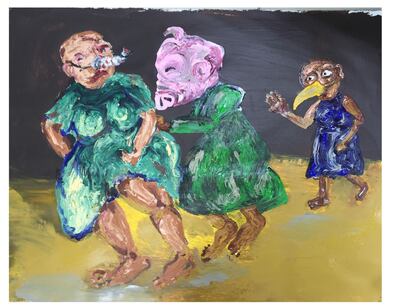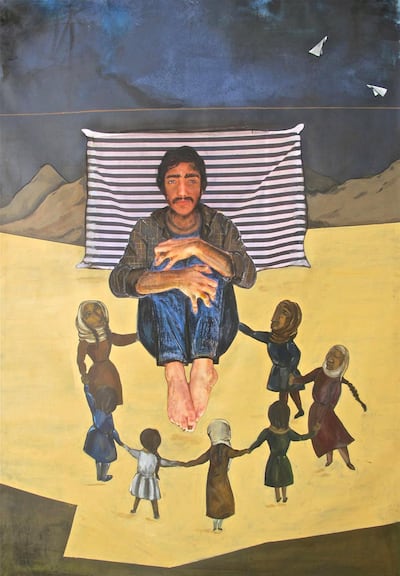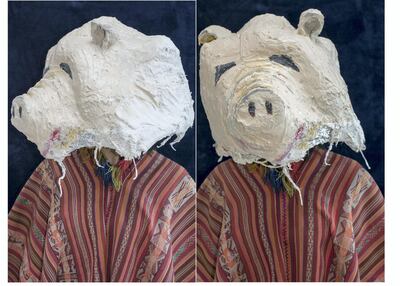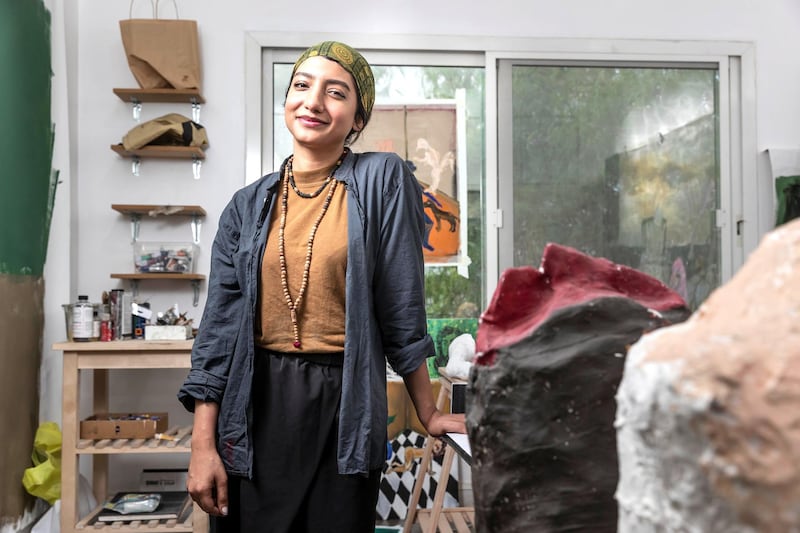When Maitha Abdalla grew up, she and her five sisters would stay with their grandmother in Khor Fakkan while her parents were abroad. "She lived in this amazing old house," says Abdalla, now an artist living in Abu Dhabi. "She liked to have ducks and chickens and roosters, and she would tell us all these stories. I remember her saying that roosters see angels. So whenever you hear a rooster, there are angels nearby, and you can ask God for forgiveness.
"I used to wake up hearing roosters, and it terrified me," she says. "Are there angels around? Or when I used to play outside, my grandmother would tell me, you should go in before sunset because demons are around then. It's nothing religious, just things that grandmothers used to say. Now, I don't hear anyone saying it."

It’s not hard to see the connection between her grandmother’s folkloric beliefs and Abdalla’s work today. Her studio is littered with rough-hewn figures that look like extras from a Surrealist fever dream: a creature with a wolf head lies on its back with two legs raised in the air, as if it has frozen mid-fall. A flesh-coloured figure kneels on all fours, with a long thin trunk that stretches down to the floor – as if a stream of vomit has gurgled from it, or its nose has grown too long. Atop a table heaving with paint cans and brushes sit a plaster rooster.
'I'm really interested in sin'
Abdalla showed the figures alongside a painting of humans turning into beasts at the graduation show last year for the Salama bint Hamdan Emerging Artists Fellowship (SEAF) programme. Installed at Warehouse421 in Abu Dhabi, the work evokes a primal scene of transformation – a physical manifestation, Abdalla says, of mental turmoil.
"I'm really interested in sin," she says affably. "For these characters, sin changes their physical appearance, and they want to change back into their pure self again. Everyone sins, no matter what your religion is – it could be going against the morals of life. But when you're a believer, it's worse, because then you have these thoughts fighting. It almost feels like you're wearing a mask, but you want to take it off so badly."

Abdalla studied sculpture at Zayed University, and then enrolled in the SEAF programme. This year, she was one of the five artists who repurposed an old villa into a space for studios and exhibitions, naming it after its number on the street: Bait 15. It’s now in its ninth month and is opening a new show for Abu Dhabi Art week, which takes place from November 14. And in Dubai next week, Abdalla has work at a new space in Alserkal Avenue – the warehouse formerly occupied by Art Jameel – which is now Zayed University’s permanent project space. The site will hold lectures, screenings, and exhibitions, functioning as a way for the Zayed students to show their work in public and enter into more open debates.
Abdallah’s art reveals something unusual: a fascination with the more fearsome elements of Khaleeji culture – the folkloric beliefs that persisted to keep children and adults safe in a harsh physical environment.
For Abdalla, it’s less the notion of sin itself that motivates her work (“Who am I to say what is a sin and what’s not?” she says), and more the idea of a gulf between outward semblance and inner feelings. It might not be surprising that she is also interested in theatricality: “Life seems like acting,” she says.

'Each story has its own medium'
When I visited her Bait 15 studio, she was working on a nearly five-metre-wide painting, which will feature in the Alserkal show. The piece stretched out along the length of the room, and comprises several scenes against its background of dark green oil paint. On the far left, a woman in a brown abaya and veil wears a waxen-like mask, with her hand raised as if mid-soliloquy. Next to her is a death scene of a figure spread out on a chaise longue, with four figures behind him who raise their hands in grief. An old man with a long grey beard – he is "authority", Abdalla says – pokes his head out of the plush red curtains of a Punch & Judy theatre, while just below him, a man and a woman imitate two roosters.
“They’re supposed to be symbols of good luck,” she says. “But here they’re fighting.” The canvas is rich with the iconography of the theatre, and indeed the scenes are, quite literally, taken from acts in a play.
Abdalla writes a script for each work of about three to four pages. “Each story has its own medium: video or painting or sculpture or performance,” she says. “My question is always: how do I move that off from the paper?”
When she was younger, she says, she tried interminably to write stories but never succeeded in the way she wanted. It was only when she met her husband, filmmaker Khalid Al Mahmood, that she understood how she could tell her stories: visually. "[Because] he works in the film industry," Abdalla says, "he introduced me to a world I didn't know before. I only grew up with Hollywood films, and then through Khalid learnt about all these artistic movies and all their beautiful imagery."
She deliberately keeps these scripts from the public, preferring to focus on the sculpture or painting they become, but has designs on a larger narrative: a full-length screenplay. She hopes her husband will someday direct it. “No wasta,” she says.
“He hasn’t read it yet. He’ll either like it or he won’t.”
Maitha Abdalla’s work will be on show at the Zayed University space off the Yard in Alserkal Avenue, Dubai, from November 12
____________________
Read more:
At Abu Dhabi's Bait 15, artist in residence takes on whole new meaning
The missing MA Ibrahim: a long-lost painting resurfaces in an Abu Dhabi villa
Emerging UAE artists are unafraid to challenge in the latest SEAF show






